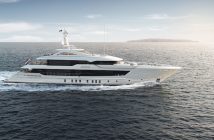Adolf Hitler invented the Smart Car. Well, perhaps not himself, but he set it in train by demanding that the German state find a true “people’s car”, the search for affordable, universal and accessible personal transport. Thus via the VW Beetle, Mini, Micra, Uno, Clio, Prius, etc, all the way up to and including the incomprehensible Smart Car, we have been chasing that impossible, hyper-efficient crock of gold at the end of a far-off rainbow. Welcome to the world of a better alternative, a classic Mercedes!
Just walk out of your front door and look at the cars parked, and passing. Unless, like me, you have grown up telling by the curve of a bumper here or the flash of chrome trim there, exactly what you are following (or is on your tail), it really does all look much the same now. And of the same age; most vehicles you may glance at are made within the last decade. Strange, don’t you think, when cars are now built to last for decades, yet we are encouraged to toss them into government scrappage schemes well before their sell-by date? We should be recycling everything we can, not squandering our resources in completely irresponsible ways. How can any government justify junking perfectly good cars on the basis that this saves jobs today at Nissan or Ford? Isn’t there a much greater moral, long-term agenda, which needs more careful thought than this?
I do occasional charity work for Oxfam and we are constantly stunned by the sheer volume of STUFF out there, of which we see a very small – but on an individual shop basis – occasionally overwhelming amount trucking through our doors in variegated plastic sacks. Personally, I am somewhat proud, apart from feeling more comfortable, wearing a slightly used Oxfam-acquired shirt or suit and thus saving a decent piece of clothing from the scrap heap. But from the Mercedes I digress…
Twelve or fifteen years ago, when I was immersed in the usual daily traumas of bringing up a family of expensively-educated boys, we went through the usual default choices of family vehicles: mainly as I recall Nissans and Ford Mondeos (yes, meet a real life Mondeo Man, and excellent family vehicles they happen to be!). Still at that time the possibility of Mercedes ownership was a distant dream, and local Mercedes dealerships never seemed to sell traded-in vehicles that were over three or four years old. (Why? Simple – if you saw a great eight-year-old on the forecourt at well under half the price of a new one, where would your money go?). This, in concert with a degree of mechanical competence that would challenge a chimpanzee meant that I was constrained from buying those thick magazines on station forecourts printed on pink or yellow toilet paper, full of questionable vehicles. Yes, you know the ones, packed with ads which talk-up clapped out (or not) bangers specifically aimed at people with my own dismal level of technical expertise.
So as I sighed and prepared to move on to the next second-hand Mondeo, one day I had a “light bulb” moment of inspiration. Why not pay a visit to the local Mercedes garage and have a word with the people at the back in the service area, rather than run the gauntlet of the Gap-suited Charlie Hensons out front? So this is what I did and lo, there sitting out the back ready to be carted away to the next trade auction (or whatever fate awaits such elderly jalopies) was a very tasty ten-year-old blue automatic saloon (230E), one lady owner – perfect! A quick chat, and as I recall, a couple of palmed ponies, and a deal was done. I became the proud owner of the most loved and hated triple-digit symbol in the world. My joy however was relatively short-lived. One day I emerged from home, and there it was gone! Disparu! “Ah yes,” said the insurance assessor wearily, “straight to Dover, on the ferry, across France to Gibraltar, ferry again and now servicing some village in Zimbabwe”. The one lady owner was thus multiplied at a stroke.
As it happens at about this time the almost mythical film director Stanley Kubrick, in a sense came to the rescue, but in a somewhat curious and roundabout way. I was then making a long-running cinema series for Channel 4 called “Cinefile” and I had already transmitted a critically acclaimed but unashamedly unauthorised documentary about him called “The Invisible Man”. Then, out of the blue in 1999, he upped and died in his sleep at home in St. Albans. Almost unbelievably, given my history of, at the very least, clear-eyed documentaries, his family embraced me and I was invited to undertake another film study, “The Last Movie”, about the making and completion of his final work, “Eyes Wide Shut”. Apart from the fact that the family subsequently banned my documentary from being seen after its first transmission, all went well throughout its making and during this time I got to know Stanley’s legendary driver, Emilio. He was a simply terrific guy, the soul of discretion, and an ex-racing driver who had been a professional colleague of Juan Manuel Fangio no less. His pride and joy was being in charge of Stanley’s 1984 Mercedes 500 SEL top-of-the-range long wheelbase saloon which must have cost £60,000 (plus extras) at the time of its purchase. As it now seemed to me to be surplus to requirements and a truly gorgeous object, I asked what he intended to do with it. He replied that now Stanley was no more, his job was done here and that he intended to return to his family in Monte Casino. So why didn’t I make an offer for it to Stanley’s brother-in-law? So I did, and I got it!
Living on the edge of East Dulwich, before it became yuppiefied, was a daily hazard in terms of schoolchildren and similar passing trade. So I lost three if not four symbols from the bonnet of my prized Mercedes, which is why you often see that owners have replaced them with a simple metallic plug. But I was not going to give in so easily. I was proud of that triangle and intended to display it come what may. So my local garage got quite used to receiving my call and replacing the famous chrome triple-triangle. The second substitute was ripped off in short order, but when I reinstated another with equal rapidity, the local louts began to get it through inches of dense cranium matter that I was serious. What did they use them for, I asked around, all these stolen chrome triangles? “They wear them around their necks as Nazi symbols” came the reply. Just imagine, Stanley Kubrick’s prized badge dangling around the scrawny neck of some spotty youth. Yarbles! (as they said in “A Clockwork Orange”).
Indeed, I can understand why it is so disliked, that Mercedes triangle spinning forever on its majestic rostrum overlooking Berlin – for now we are back to Herr Hitler again. Remember those shots of him being driven to big events in that very city – always in a wonderful open-topped Mercedes? I remember too, very vividly, a single tracking shot from Leni Riefentahl’s “Triumph of the Will” which is simply a close-up shot of Hitler’s upraised hand, during one of his driving tours, whilst in the out-of-focus background the cheering crowd race by in tumbled confusion. And what is that hovering at the edge of the frame? You’ve guessed it, the Mercedes symbol crouching above the gleaming bonnet. So how can I, whose parents helped carry this country (and myself indeed) through the darkest days of the last century, actually cherish such a representative of a totally corrupt and totalitarian regime? My answer comes from Peter Sellers’ classic line from “Dr Strangelove”, (yes, indeed directed by Stanley Kubrick himself), where as the British Wing Commander he is recalling the brutal treatment he received at the hands of Japanese officers in his POW camp, and he says ruefully, “The trouble is, they make such bloody good cameras”. Enough said?




